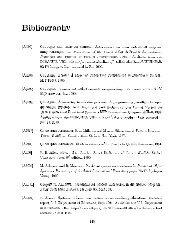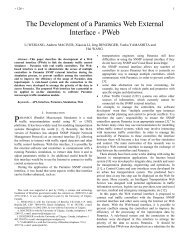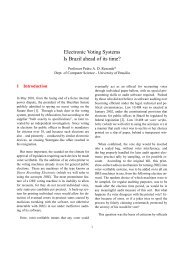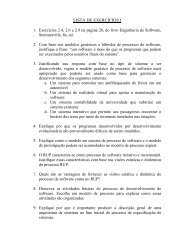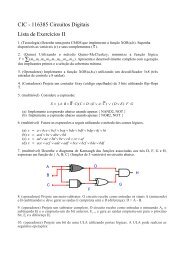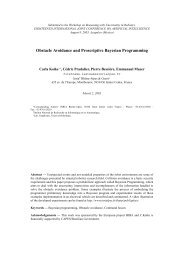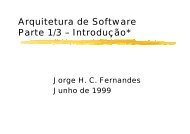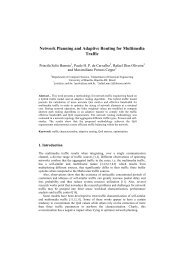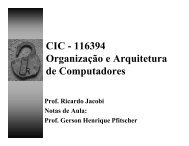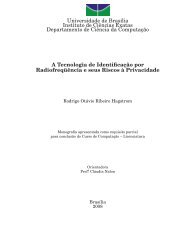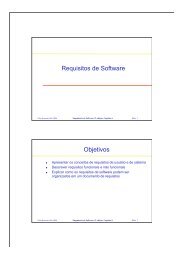You also want an ePaper? Increase the reach of your titles
YUMPU automatically turns print PDFs into web optimized ePapers that Google loves.
ances were perceptually accurate see Sec. II D; all measureswere made from the aerodynamic signals.Data were collected using a PowerLab 4SP connectedto a laptop computer. Before recording began, all inputs wereadjusted to yield adequate signal-to-noise levels. Acousticsignals were low-pass filtered at 10 kHz and sampled at20 kHz. Acrodynamic signals were low-pass filtered at5 kHz and sampled at 10 kHz. The signals and speakerswere monitored throughout recording to ensure that the airflowmask was pressed tightly to the face, and that the pressuretube was not clogged with saliva. At the beginning orend of each recording session, pressure and flow calibrationvalues were obtained using a water manometer for the pressureand a rotameter for the airflow.The airflow recording methods used here differed fromMüller and Brown 1980 in using a standard, unalteredpneumotachograph. Those authors, in contrast, adjusted theirairflow mask to limit dead air space and avoid flows associatedwith lip and jaw movement. Specifically, they filled thearea between the upper lip and nose with foam rubber andcaulk, and affixed a sheet of dental dam material to the lowerlip. These modifications were not implemented here partlybecause they were impractical for recording young children,and most studies on speech aerodynamics have used unalteredmasks. Most important, perhaps, the signals obtainedfrom the standard mask permitted reliable measurement ofthe two events necessary, namely oral closure and release.The relevance of this methodological difference for directlycomparing this work to that of Müller and Brown is consideredin Sec. III D.C. Speaking taskPictured stimuli were used to elicit multiple productionsof the utterances “Poppa Popper” and “Poppa Bopper.”Poppa Popper had a bowl of popcorn, and a large P on hisshirt; Poppa Bopper was “bopping” a large block, inscribedwith a B, with a mallet. The stimuli were introduced to thespeakers before recording took place. During recording, apicture was presented to the speaker, who then repeated theutterance five times. A research assistant presented the picturesand maintained the children’s interest throughout thetask. Each picture was presented five times during the recordingsession, in randomized order, resulting in approximately25 productions per consonant.D. Exclusion criteriaFIG. 1. Sample production of /.bÄ/ “Poppa Bopper” showing events usedfor measurement. Top panel: Original grey and smoothed black oral airflow.The three vertical lines indicate the times of a closure, b voicingoffset, and c release. In fully voiced tokens like the one shown here, thetime of voicing offset was set just preceding the time of release. Secondpanel: Second time derivative of smoothed oral flow. Third panel: Originalgrey and smoothed black intraoral pressure P io . All signals are temporallyaligned.Tokens were discarded when a monitoring of thespeaker or the airflow data suggested that an airflow leakmay have occurred; b the target consonant was not perceptuallyaccurate in voicing, place, and manner; c the flowsignals for the target stop did not show abrupt changes associatedwith vocal-tract closure and release, suggesting lenitionor spirantization, and/or if second derivative peaks definingclosure or release could not be identified with certaintydescribed further in the next section; ord P io did notreturn to near-baseline during the unstressed vowel precedingthe target consonant, with “near-baseline” defined as1cmH 2 O. Cases with nonbaseline pressures primarily occurredin a few 10 year olds who used faster speech rates.Most other exclusions in the children owed to airflow leakse.g., the child moved and mask seal was not maintained orlenition. In total, 1017 pressure traces were analyzed 510 for/b/ and 507 for /p/; there were 282, 305, and 430 tokens forthe 5 year olds, 10 year olds, and women, respectively. Subjectscontributed an average of 21 tokens each of /p/ and /b/to the data pool range=10–31 tokens per consonant perspeaker.E. Measurement of voicing and closure durationInitial data analyses used the CHART software accompanyingthe PowerLab system. A sample token from a10 year old is given in Fig. 1. All measures were made on thetokens of /p, b/ initiating the third, stressed syllable of theutterance. The times of voicing offset during the consonantalclosure were identified visually from the unsmoothed airpressure and airflow signals. To determine the times of articulatoryclosure and release, the airflow signals weresmoothed twice with a 201-point window, the signal wasdifferentiated twice, and the resultant was smoothed. Releaseand closure were defined by finding those peaks in the secondderivative signal that corresponded to the corners of theflat region in the flow signal demarcating the consonantalclosure. This method of determining stop closure and releasewas particularly useful when the flow signals showed effectsof supraglottal movement i.e., baseline shifts during stopclosures, but it differed from that of Müller and Brown1980, who made closure and release judgments visuallyfrom the unsmoothed flow signals. Since smoothing the flowand its derivatives could introduce some temporal noise, thedata from one woman 38 tokens were remeasured usingvisual inspection of the unsmoothed flow signals, to verifythat the two measurement procedures yielded similar results.The closure and release times obtained via the two methods1080 J. Acoust. Soc. Am., Vol. 123, No. 2, February 2008 L. L. Koenig and J. C. Lucero: Voicing and intraoral pressure
FIG. 2. Schematic signals showing time and amplitudemeasures made to quantify the shape of the pressurepulse, following Müller and Brown 1980.differed by average of 2 ms s.d.=5 ms. This aspect of ourmethods, therefore, appears not to be of concern for a comparisonwith Müller and Brown.Times of oral closure, oral release, and voicing offsetpermitted calculation of a closure duration, b voicing duration,and c percentage of the closure that was voiced.Absolute duration of voicing was included following Westburyand Keating 1986. Percentage of voiced closure wasincluded because children tend to have slower speech ratesand longer segment durations than adults e.g., Kent and Forner,1980; Smith, 1978, 1992. Thus, even if children producethe same duration of voicing as adults, they may showproportionally less voicing during a stop, and be perceived todevoice more frequently. Finally, the number of devoicedstops productions of /b/ was assessed, following Smith’s1979 suggestion that these may be more prevalent in childrenthan adults. Drawing on studies that have quantifiedclosure voicing in both voiced and voiceless stops Docherty,1992; Flege and Brown, 1982; Westbury, 1979 a cutoffpoint of 30% voiced closure was selected for designatingvoiced stops as “devoiced” in production. In the cited work,voicing was observed to persist into target voiceless stops upto 30% of the closure. Using this cutoff, each subject’s /b/tokens were classified as partially voiced 30+% voiced ordevoiced 30% voiced.Since voicing offset was determined visually, a randomlychosen 20% of all tokens was remeasured by the firstauthor to assess reliability. Although most of the originalmeasures were made by graduate-student research assistants,a portion was made by the first author; of the remeasureddata, 78% represented inter-rater reliability original measuresmade by students and 22% represented intra-rater reliability.Correlations between the original and remeasureddata showed high reliability, both for voicing duration calculatedin milliseconds and as a percentage of closure, and forinter- and intra-rater reliability all r values 0.96 or higherand all p values 0.0001. For intra-rater reliability, themean absolute measurement error was 5.2 ms for voicingduration s.d.=6.9 and 0.06 i.e., 6% for the proportion ofclosure voiced s.d.=0.09. For inter-rater reliability, meanvoicing duration error was 3.0 ms s.d.=6.6 and for voicingpercentage it was 0.03 s.d.=0.08.F. Pulse shape calculationsThe unsmoothed pressure signal for each token of /p/and /b/ was extracted in the CHART program, using a timewindow wide enough to include the stop closure and releaselabels as defined earlier, and read into MATLAB for pressurepulse calculations. Following Müller and Brown 1980, thesignals were low-pass filtered at 43 Hz using a sixth-orderButterworth filter, filtering both forwards and backwards tominimize temporal delay. From this smoothed signal, severalparameters were calculated to permit characterization of thepressure pulse shape. These parameters are shown for a schematicexample at the left of Fig. 2: Tc=time of closure identifiedfrom the second derivative of the flow signal, as indicatedearlier. Pc=pressure at closure. Tr=time of releasefrom second derivative of flow signal. Pr=pressure at release.To=closure duration Tr−Tc. Ta=time to pressureaverage. Pa=pressure average relative to Pc. The averagewas obtained by integrating the smoothed pressure signalbetween Tc and Tr and Pc was then subtracted from theresultant. Pk=pressure peak. Pd=pressure difference betweenclosure and release Pr−Pc. =slope of the hypotenuseof the triangle formed by Ta and Pa. =slope of thehypotenuse of the triangle formed by To−Ta and Pd−Pa. =−.As shown in Fig. 2 middle and right panels, a pressurepulse that rises quickly and then levels off should have ahigh slope, low slope, and 0, whereas a slow initialrise followed by more rapidly increasing pressure shouldyield 0.In addition to the , , and measures, normalizedslopes n , n , n were calculated by multiplying , , and by To/Pd. Müller and Brown 1980 proposed this procedureto adjust for differences in closure and pressure pulseduration. Specifically, normalization corrects for the fact thatlengthening a closure e.g., as a result of a slower speechrate, given a constant rate of pressure increase, will lead to ahigher pressure at release.G. Statistical analysisRepeated measures analyses of variance ANOVAswere conducted on voicing duration, percentage of closurevoicing, , and n measures, with consonant as the withinsubjectfactor and age as the between-subject factor. Aunivariate ANOVA, with age as the independent variable,was used to analyze the percentage of devoiced /b/ for eachspeaker. The Bonferroni-corrected level for determiningsignificance in the five ANOVAs was 0.05/5=0.01. To quantifythe relationship between voicing and P io characteristics,within-subject correlations were run for and the duration ofclosure voicing. For 24 correlations, the adjusted level was0.05/24=0.002.J. Acoust. Soc. Am., Vol. 123, No. 2, February 2008 L. L. Koenig and J. C. Lucero: Voicing and intraoral pressure 1081
FIG. 3. Amount of closure voicing, in milliseconds top, and as a percentageof the closure duration bottom. Closed bars represent /b/; open represent/p/.III. RESULTSSections III A and III B address group i.e., age effectsin voicing and pressure measures. Section III C assesses therelationship between voicing and pressure data. Section III Dcompares the current data with those of Müller and Brown1980, incorporating the post-hoc analysis of two men.FIG. 4. top and normalized n bottom values for each speaker group.Closed bars represent /b/; open represent /p/.percentages for /p/ voicing, in ascending age order, were12%, 16%, and 12%; for /b/, they were 36%, 59%, and 64%.The proportions of devoiced stops for all speakers aregiven in Table II. Although devoicing was most common onaverage in the 5 year olds, the incidence of devoiced /b/varied considerably within groups, and the group effect didnot reach significance F2,21=3.968, p=.035.A. Stop closure and voicing durationsClosure voicing durations and percentages of closurevoicing are shown for each speaker group in Fig. 3. ANOVAresults for the two measures are given in Table I. As expected,voicing was more extensive for /b/ than /p/, measuredboth as a duration and as a percentage of the closure. Theconsonant effect was highly significant in both ANOVAs. Amain effect of age was not significant for either analysis. Thegroup-by-consonant interactions did not reach significanceeither, although the one for voicing percentage approached itp=0.018. Qualitatively, the percentage of closure voicingfor /p/ was similar across ages, whereas for /b/ it increasedsomewhat over age see bottom panel of Fig. 3. The actualTABLE I. ANOVA results for closure voicing measured as a duration and asa percentage of the closure duration.Voicing durationEffect dfs F pConsonant 1, 21 115.432 0.0001Group 2, 21 0.678 0.518Consonantgroup 2, 21 2.955 0.074Voicing percentageEffect dfs F pConsonant 1, 21 102.595 0.0001Group 2, 21 2.314 0.124Consonantgroup 2, 21 4.927 0.018B. Pressure contoursThe analysis was intended to quantify pulse shape,with values of 0 indicating convexity. The n values arethe normalized, unitless counterparts designed to correct forspeech rate differences, all else being equal. Group resultsfor and n are shown in Fig. 4. The ANOVA results aresummarized in Table III.For , the consonant effect was highly significant, butthe group effect failed to reach significance p=0.024, asdid the group-by-consonant interaction. The results for nwere rather different: Neither of the main effects nor thegroup-by-consonant interaction approached significance. Asshown in Fig. 4 lower panel, the 10 year olds and womenstill had the expected pattern of higher values in /p/ comparedto /b/; the 5 year olds did not, and had a markedlyhigher standard deviation s.d. for /b/.To determine why n means and s.d.s differed so muchfrom those of in the 5 year olds, the two parameters used toobtain n from , namely closure duration To and the pressuredifference between release and closure Pd, were inspected.The results for pressure at closure Pc and releasePr were also reviewed to clarify the Pd data. The groupmeans and s.d.s for these four measures are given in TableIV.Table IV shows that the 5 year old’s high n s.d.s for /b/reflect variability in both Pd and To, but compared to womenthe s.d.s for Pd were proportionally higher than those for To1082 J. Acoust. Soc. Am., Vol. 123, No. 2, February 2008 L. L. Koenig and J. C. Lucero: Voicing and intraoral pressure
TABLE II. Proportions of /b/ productions in which 30% or more of the closure was voiced. In the child groups, the first four speakers are females; the lastfour are males.Speakers 1–8 in each groupGroupaverage5 year olds 0.12 0.35 0.38 0.06 0.79 0.89 1.00 0.11 0.4610 year olds 0.55 0.75 1.00 1.00 0.88 0.23 0.63 1.00 0.75Women 1.00 0.82 0.80 0.87 0.48 0.93 0.97 0.92 0.852.1 vs 1.7. Pd variability, in turn, reflects variability in bothPc and Pr: s.d.s for both are higher in the 5 year olds than thewomen. As for the mean values, both Pd and To are higher inthe 5 year olds than the adults, but proportionally more sofor Pd 1.8 times the adult value than for To 1.4–1.5 timesthe adult value. As laid out in Sec. I, age-related differencesin durations and intraoral pressures were expected for a varietyof reasons. The normalization method proposed byMüller and Brown 1980 is designed to correct for higherpressures that arise simply as a function of longer durations.The current data show both longer durations and higher pressuresin 5 year olds than adults, but the pressure differencesare proportionally greater. Because these two parameters donot change in parallel with age, it appears that this method of normalization is not appropriate for comparing across agegroups.The data presented above indicate that differentiated/p/ and /b/ on average for all age groups. To determine howwell this held for individuals, the difference between /p/and /b/ was obtained for each speaker. If intraoral pressurerises faster in /p/ than /b/, the difference should be positive.The results are given in Fig. 5. Interspeaker variability isconsiderable for all groups, but most values are positive;negative values occur only among the children. 2 Thus, the/p/-/b/ difference observed in the averages is reflective ofmost speakers.C. Relations between stop consonant voicing andpressure measuresTo quantify the relationship between pressure pulse trajectoriesand the degree of stop consonant voicing, withinsubjectcorrelations were run on and closure voicing durationfor /p/ and /b/ combined. 3 The results are given in Fig. 6.As expected, r values are usually negative: As becomesmore positive as for a convex pulse, the amount of voicingdecreases. The three child speakers with positive r values areTABLE III. ANOVA results for the pulse shape measure and its normalizedcounterpart n .Effect dfs F pConsonant 1, 21 35.006 0.0001Group 2, 21 4.497 0.024Consonantgroup 2, 21 2.742 0.087 nEffect dfs F pConsonant 1, 21 1.853 0.188Group 2, 21 0.153 0.859Consonantgroup 2, 21 1.199 0.321the same as those with negative differences between /p/and /b/. Significant correlations using a criterion of0.05/24=0.002 are indicated in Fig. 6 by asterisks. Thenumber of significant correlations increases with age; that is,the relationship between pressure pulse parameters and voicingis more consistent in adults.D. Comparison with Müller and BrownThis section assesses how the current results comparewith those of Müller and Brown 1980. Those authors didnot explicitly measure closure voicing, so this discussion islimited to the measure; n is not considered because of theuneven nature of age-related changes in To and Pd noted inSec. III B.As indicated earlier, the current methods differed in afew ways from those of Müller and Brown 1980: Here,closure and release were measured semiautomatically fromthe acceleration of the flow signal addressed in Sec. II E; astandard pneumotachograph was used, without employingthe adjustments used by Müller and Brown; and the adultgroup consisted of women rather than men. The mask differencerelates only to the airflow-based measures of closureand release, and should not affect the pressure measuresthemselves. The gender difference, however, could affectpressure measures given that women, on average, havesmaller vocal tract sizes than men. Thus, to allow a morevalid comparison with Müller and Brown, equivalent datawere recorded from two men and analyzed in the same manneras the women and children to obtain measures. Valuesof from Müller and Brown were estimated to the nearest0.005 cm H 2 O/ms from their plots for bilabial stops in the/Ä/ vowel context. That study also included alveolar consonantsand a high vowel context. Since Müller and Brown’ssubjects all produced the same number of tokens N=6,group averages could be estimated from the individual subjectaverages.As shown in Table V, values obtained here for both /p/and /b/ were higher than Müller and Brown’s 1980, particularlyfor the children. A general pattern of descending valuesfor /b/ across 5 year olds, 10 year olds, women, and menin Table V provides qualitative support for the hypothesisthat intraoral pressure tends to rise more slowly in those withlarger vocal tracts. This is consistent with the data in TableIV: The pressure rise during closure, Pd, was higher in childrenthan women, and to a greater degree than closure duration,To. The average differences between Müller andBrown’s data and the current adult speakers appear to reflectsampling error, however. Müller and Brown’s data showedconsiderable intersubject variability in , and standard devia-J. Acoust. Soc. Am., Vol. 123, No. 2, February 2008 L. L. Koenig and J. C. Lucero: Voicing and intraoral pressure 1083
TABLE IV. Descriptive data for closure duration To, pressure difference in the closure Pd, pressure atclosure Pc, and pressure at release Pr. To and Pd are the two measures used to n from ; Pd=Pr−Pc. Eachcell in the first three rows shows the group mean standard deviation. The last row provides the ratio of the5 year olds to the adults means and standard deviations calculated separately.Closure duration ToPressure differencePdPressure at closurePcPressure at releasePr/b/ /p/ /b/ /p/ /b/ /p/ /b/ /p/5 year olds 106.7 17.9 113.7 21.4 4.9 1.9 5.2 1.8 2.5 0.8 3.4 1.1 7.4 2.0 8.6 1.910 year olds 86.7 17.9 82.9 18.0 3.9 0.9 4.4 0.7 2.4 0.8 3.9 1.5 6.3 1.2 8.3 1.8Woman 75.5 10.4 75.6 9.6 2.7 0.9 2.9 1.2 1.7 0.5 2.9 0.9 4.3 1.1 5.8 1.5Ratio: 5 yearolds to women1.4 1.7 1.5 2.2 1.8 2.1 1.8 1.5 1.5 1.6 1.2 1.2 1.7 1.8 1.5 1.3tions for were also fairly large here refer back to Fig. 4.Review of the women’s data showed four cases in whichindividuals had values at or lower than Müller and Brown’saverages. The same was true for one 10 year old. Thus, thecurrent adult data overlap with those of Müller and Brown,and appear to be generally consistent with the results of theearlier study. Section IV raises some issues concerning which may explain the wide variation in even in adultspeakers.IV. DISCUSSIONA. Age and stop consonant voicingPast studies have found that children up to 6 years ofage produce fewer voiced stops and less closure voicing thanadults e.g., Barton and Macken, 1980; Kewley-Port and Preston1974; Smith, 1979; Zlatin and Koenigsknecht, 1976.Qualitatively, the current data showed the least /b/ voicingand the largest number of devoiced /b/ productions in the5 year olds, but age effects did not reach significance for anyof the voicing measures. Four factors should be consideredin interpreting this result: a nature of the voicing contrast inEnglish; b phonetic context; c age of the children; and dsample size.Given that closure voicing is not obligatory in stressed,syllable-initial contexts in American English e.g., Liskerand Abramson, 1964; Zlatin, 1974, all speakers have theoption of producing voiceless unaspirated stops, which maybe motorically less demanding Kewley-Port and Preston,1974. At the same time, the intervocalic frame in which thetarget consonants appeared here tends to facilitate closurevoicing. Children might be particularly susceptible to factorsfavoring devoicing Westbury and Keating, 1986, but to ascribea lack of significant age effects here to the intervocaliccontext would be to assert that children have a stronger positionalbias toward voicing. Given smaller vocal tract sizesand higher phonation threshold pressures in children, there isno reason to think they should be more likely to voice in anintervocalic position than adults. That is, the phonetic contextmay have predisposed all speakers to produce voicedstop closures, but this should not have made age differencesless likely.More likely is that the children’s ages and the groupsizes had the effect of minimizing age effects. Past developmentalstudies of consonant voicing have mostly concentratedon very young children. The requirements of the experimentaltask used here precluded recording childrenyounger than about 4 years, and the younger group includedindividuals nearing their sixth birthday. These children werethus at the upper end of the age range at which group differenceshave been demonstrated. The intensive within-speakerprocessing here also limited group sizes. Finally, the childrenshowed considerable intersubject variability, as has oftenbeen observed e.g., Eguchi and Hirsh, 1969; Kent and Forner,1980. With a larger sample size, the mean group differencesmay have outweighed the within-group variability toproduce a significant age effect e.g., Kirk, 1999.In contrast to the 5 year olds, the 10 year olds werequalitatively as well as statistically comparable to the womenin their voicing measures. Although a few studies have reportedVOTs for voiced stops in children of this age KentFIG. 5. Differences between values of /p/ and /b/ for each speaker.FIG. 6. Results of correlations Pearson’s r values between and durationof closure voicing for each speaker. Asterisks mark speakers for whom thecorrelation was significant at p0.002.1084 J. Acoust. Soc. Am., Vol. 123, No. 2, February 2008 L. L. Koenig and J. C. Lucero: Voicing and intraoral pressure
TABLE V. Comparison of current measures with those from Müller andBrown 1980, p. 342. The data from the earlier study are estimated fromindividual subject plots.Current study 5 year olds 0.088 0.10910 year olds 0.083 0.141Women 0.040 0.104Men 0.033 0.119Müller and Brown 0.010 0.067and Forner 1980; Ohde, 1985; Whiteside et al., 2004, theirdata do not clearly indicate the degree of closure voicing,since a positive VOT may indicate a truly voiceless stop aswell as one in which voicing dies out before the end of theclosure. Based on the current results, it appears that 10 yearolds demonstrate essentially mature closure voicing in /b/,despite continuing differences from adults in vocal tractsizes, aerodynamic quantities, speech segment durations, andtoken-to-token variability e.g., Bernthal and Beukelman,1978; Eguchi and Hirsh, 1969; Goldstein, 1980; Kent andForner, 1980; Netsell et al., 1994; Stathopoulos and Weismer,1985; Walsh and Smith, 2002. These older childrenmay thus have mastered methods of vocal-tract pressuremanagement so as achieve adult-like closure voicing. Thesame explanation may hold for those 5 year olds whose voicingbehavior was more adult-like. One difficulty with thisinterpretation, particularly for the younger children, is thatthe correlations between voicing and introral pressure cf.Sec. IV C were less often significant in children than adults,and sometimes reversed. Modeling of closure voicing withlaryngeal and vocal tract models scaled to child sizes mayprovide greater insight into the conditions needed to producevoiced stops in child speakers.B. Quantitative pressure pulse analysis and agePast work has established that children as young as4 years of age, like adults, produce higher peak P io in voicelessstops than in voiced Arkebauer et al., 1967; Bernthaland Beukelman, 1978; Brown, 1979; Lisker, 1970; Malécot,1966; Miller and Daniloff, 1977; Stathopoulos and Weismer,1985; Subtelny et al., 1966; Warren and Hall, 1973, therebydemonstrating some aerodynamic differentiation of consonantsaccording to voicing category. At the same time, previousauthors particularly Kewley-Port and Preston, 1974have attributed limited closure voicing in young children toimmature control over intraoral pressure, and Müller andBrown 1980 specifically suggested that P io might rise fasterin children than adults. These results led to the predictionthat and its normalized counterpart n would differ betweenchildren and adults.The data for showed a significant consonant effect, butage effects failed to meet significance. Comparison of thewomen and children’s data with two men recorded post-hocand those recorded by Müller and Brown 1980 showeddecreasing values for speakers with larger vocal tracts,providing some support for the possibility of a size-relatedtrend, and it may be again that a larger sample size and/or a/b//p/younger group of children would yield significant age effects.Alternatively, children may perform more extremevolumetric adjustments than adults in order to control P ioincreases in their smaller vocal tracts but see again the commentson this point in Sec. IV C.The results for n showed neither age nor consonanteffects. Inspection of the measures used to derive n from ,namely closure duration To and pressure difference in thestop Pd, showed proportionally greater age differences forPd. This suggests that is a more valid measure for comparingacross ages than n . The normalized measure may, however,still be appropriate to adjust for speech rate or loudnessdifferences within individual speakers or age groups.C. Relationships between P io and voicingThe differences between /p/ and /b/ were in the expecteddirection for most speakers, but reversed for three ofthe children. Further, correlations between and voicing durationwere significant for all of the women and for 7/8 ofthe 10 year olds, but only 3/8 of the 5 year olds. Thus,whereas adults have established consistent relationships betweenstop consonant voicing and P io characteristics, as measuredby , many 5 year olds and a few 10 year olds havenot. Correlations in the expected direction that were statisticallyinsignificant suggest that some children may haveimplemented control over P io buildup in target voiced stopswhich was not extensive enough to maintain voicing, or elsethat they exercised such control inconsistently. Correlationsin the reverse direction suggest that some children have infact not yet learned how to manipulate intraoral pressure inorder to maintain voicing. Both of these cases speak againsta general developmental strategy in which children activelyincrease supraglottal volumes more than adults in an attemptto sustain voicing: In such a situation, one might expect evenstronger correlations in children than adults. It is also possiblethat the measure is not sufficient to capture all aspectsof aerodynamic control relevant for stop consonant voicing.As discussed in the following, some unexpected values of were encountered in the course of this work, lending supportto this last interpretation.D. Comparison with Müller and Brown and critiqueThe measures obtained here were somewhat higher, onaverage, than those obtained by Müller and Brown 1980.The particularly high values for /b/ in children compared towomen as well as men may represent a tendency for speakerswith smaller vocal tracts to have limited possibilities for supralaryngealvolume adjustments, but the differences amongthe adults appear to reflect normal cross-speaker variation.Different speech materials may also contribute to variancebetween the two corpora. Whereas the current study placedthe target consonants in an intervocalic, running speech context,Müller and Brown elicited their consonants in isolated,symmetrical, nonsense VCV utterances, with instructions toproduce equal stress on the two syllables. Conceivably, differencesin stress pattern or speaking style may influence measures.J. Acoust. Soc. Am., Vol. 123, No. 2, February 2008 L. L. Koenig and J. C. Lucero: Voicing and intraoral pressure 1085
FIG. 7. A token of /b/ produced by a 5-year-old girl which yielded a negativevalue of Pd difference between Pc, pressure at closure, and Pr, pressureat release.Müller and Brown 1980 were unique in proposingmethods of measuring time-varying aspects of P io duringstop closures. The results of their own and subsequent aerodynamicmodeling e.g., Westbury, 1983; Westbury andKeating, 1986 suggested further that the time course of P ioincrease during stop consonants could provide informationon aerodynamic management of voiced stops. For these reasons,the current work employed the measure, proposed byMüller and Brown as a simple metric for capturing aspects ofP io pulse shape. Yet the data obtained here, as well as closeinspection of Müller and Brown’s own data, suggest that thismeasurement method may have limitations. Specifically,some of the measures used to calculate and n yieldedunexpected values. These primarily reflected two situations:Cases where Pd pressure difference between release andclosure and angle from average to release pressure werenegative. Pressure pulse depictions like those in Fig. 2 leadone to expect both to be positive. The next paragraphs brieflydescribe how these values came about.Negative values of Pd occurred in five tokens threefrom children, two from men; four of the five were in /b/.An example from a 5 year old is given in Fig. 7. This tokenalso had a negative . In this production, intraoral pressuredecreases right before release. Although these examples areinfrequent in our database, they appear to indicate that supraglottalmovements affecting pressure contours may be initiatedrather late during the closure.Whereas negative Pd was rare, negative was morecommon, occurring in 155 tokens 15% of the data forwomen and children combined. These were found acrossage groups 36%, 39%, and 26% came from women, 10 yearolds, and 5 year olds respectively, and were about equallydistributed across consonants 53% for /p/; 47% for /b/. Tokenswith negative also accounted for 12% of the men’sdata. Negative occurs when the rise from closure to averagepressure Pa is greater than the pressure difference betweenclosure and release Pd. Such values may also haveoccurred in Müller and Brown’s 1980 data: Their plotsshow some speaker averages close to zero, with standarddeviations consistent with negative values. The occurrence ofnegative changes the interpretation of : Higher values of may result not only from convex wave forms, but alsofrom pressure contours that fall between the time of averagepressure and the time of release. To determine whether valuesof negative affected the conclusions, all statistics basedon or n were rerun without tokens whose values werenegative. The results were similar or identical to the originalones, suggesting that the occurrence of negative does notaffect the general pattern of results in this work. Further,case-by-case review of these − tokens did not show them tobe atypical in ways other than their values; that is, theyappeared to represent legitimate data points. The main observationto be made here is that Müller and Brown’s measurementmethods may yield some paradoxical values, and may reflect not only the convex/concave nature of a pressurepulse. It appears that more work is needed on how best toassess the time-varying characteristics of intraoral pressuredata.V. CONCLUSIONSAn extensive literature, using VOT as well as other measures,has indicated that stop consonant voicing is more limitedin preschool children than in adults. This has been attributedto poor aerodynamic control in the context ofanatomical growth and physiological maturation, processeswhich persist into adolescence. The current study usedMüller and Brown’s 1980 measure to assess the relationshipbetween P io characteristics and stop consonant voicingin children and adults. Unexpectedly, measures of voicingand did not differ significantly across age groups. For the5 year olds, this may reflect limited sample sizes, but it appearsthat by 10 years of age, children have learned to producevirtually adult-like voicing patterns despite immaturephysical systems. The correlational patterns between andstop consonant voicing do suggest, however, that aerodynamiccontrol of voicing in children is still subject to morevariability than in adult speakers, and that some children,particularly at 5 years but maybe also at 10 years, have notyet learned to manipulate intraoral pressure as effectively asadults.When interspeaker variability is taken into account, values for the current adult speakers seem consistent withthose of Müller and Brown 1980, although varying stimulusmaterials may have yielded some differences between thetwo studies. More interesting is that issues arose relative tothe measure itself. Paradoxical values of appear to haveoccurred in Müller and Brown’s data as well as our own.Although these difficulties do not negate the conclusions ofMüller and Brown regarding mechanisms of pressure controlin adults, they do suggest that new methods of assessingtime-varying characteristics of intraoral pressure data shouldbe devised in order to characterize the data more fully andappropriately. Future work should explore this topic further.ACKNOWLEDGMENTSSeveral students from Long Island University, BrooklynCampus and New York University contributed to recordingand data analysis for this project. In alphabetical order: GiridharAthmakuri, Jesse Farver, Linda Greenwald, Ingrid Katz,Karen Keung, Elizabeth Perlman, Simcha Pruss, and GabrielleRothman see Rothman, et al., 2002. Thanks to Elaine1086 J. Acoust. Soc. Am., Vol. 123, No. 2, February 2008 L. L. Koenig and J. C. Lucero: Voicing and intraoral pressure
Russo Hitchcock for assistance in subject recruitment andscheduling; to Linda Hunsaker for creating the stimulus pictures;to W. Einar Mencl and Scott Youmans for statisticaladvice; and to Anders Löfqvist, Katherine S. Harris, ArthurAbramson, Brad Story, and four anonymous reviewers forcomments on earlier versions of this manuscript. This workwas supported by NIH Grant No. DC-04473-03 to HaskinsLaboratories and by Conselho Nacional de DesenvolvimentoCientifico e Tecnologico-CNPq Brazil.1 In addition to convex, concave, and linear, Müller and Brown also categorizeda few tokens as bimodal double-peaked or delayed increasingslope, then a flat region, then increasing slope again. These five categorieswere further divided into tokens that had an abrupt slope change in therising phase of the curve breaking tokens versus those that did notsmooth tokens. Although the original analysis of our data included thiscategorization, rater reliability was unacceptably low for the full tencategoryanalysis, so those results are not included here. Because the currentpaper only presents data for Müller and Brown’s quantitative analysis,some details of the qualitative measurement scheme have been supressedin the main text.2 The speech of the children with negative values was not obviously remarkablein other ways; for example, it was not the case that more tokenswere discarded from these children because of production errors.3 The two consonants were combined here in order to provide the mostgeneral picture of how voicing and pressure are related. The primary articulatorydifference between /p/ and /b/, viz. vocal fold abduction, shouldlead to a faster pressure increase in /p/ i.e., higher as well as a reductionin voicing. Voicing in milliseconds is used here following the onestudy that explicitly compared closure voicing and P io trajectories Westbury,1983. Correlations between and voicing as a percentage of theclosure were qualitatively similar, but most r values were somewhat lowerand fewer values reached significance. Finally, correlations for /b/ alonealso yielded a majority of negative values 21 of 24 speakers, but only 2of 24 p values reached significance. Some reduction in statistical significanceis to be expected in both cases simply because only about half asmany data points were included in each analysis.Allen, G. D. 1985. “How the young French child avoids the pre-voicingproblem for word-initial stops,” J. Child Lang 12, 37–46.Arkebauer, H. J., Hixon, T. J., and Hardy, J. C. 1967. “Peak intraoral airpressures during speech,” J. Speech Hear. Res. 10, 196–208.Atkinson, J. E. 1978. “Correlation analysis of the physiological featurescontrolling fundamental voice frequency,” J. Acoust. Soc. Am. 63, 211–222.Barton, D., and Macken, M. A. 1980. “An instrumental analysis of thevoicing contrast in word-initial stops in the speech of four-year-oldEnglish-speaking children,” Lang Speech 23, 159–169.Bell-Berti, F. 1975. “Control of pharyngeal cavity size for English voicedand voiceless stops,” J. Acoust. Soc. Am. 57, 456–461.Bernthal, J. E., and Beukelman, D. R. 1978. “Intraoral air pressure duringthe production of /p/ and /b/ by children, youths, and adults,” J. SpeechHear. Res. 21, 361–371.Bosma, J. F. 1975. “Anatomic and physiologic development of the speechapparatus,” in The Nervous System: Human Communication and its Disorders,edited by D. B. Tower Raven, New York, Vol. 3, pp. 469–481.Brown, W. S., Jr. 1979. “Supraglottal air pressure variations associatedwith consonant productions by children,” in Current Issues in the PhoneticSciences: Proceedings of the IPS-77 Congress, edited by H. Hollien and P.Hollien Benjamins, Amsterdam, Vol. 2, pp. 935–944.Crelin, E. S. 1987. The Human Vocal Tract: Anatomy, Function, Development,and Evolution Vantage, New York.de Troyer, A., Yernault, J.-C., Englert, M., Baran, D., and Paiva, M. 1978.“Evolution of intrathoracic airway mechanics during lung growth,” J.Appl. Physiol.: Respir., Environ. Exercise Physiol. 44, 521–527.Docherty, G. 1992. The Timing of Voicing in British English ObstruentsForis, Berlin.Eguchi, S., and Hirsh, I. J. 1969. “Development of speech sounds in children,”Acta Oto-Laryngol. 57, 1–51.Fitch, W. T., and Giedd, J. 1999. “Morphology and development of thehuman vocal tract: A study using magnetic resonance imaging,” J. Acoust.Soc. Am. 106, 1511–1522.Flege, J. E. 1982. “Laryngeal timing and phonation onset in utteranceinitialEnglish stops,” J. Phonetics 10, 177–192.Flege, J. E., and Brown, W. S., Jr. 1982. “The voicing contrast betweenEnglish /p/ and /b/ as a function of stress and position-in-utterance,” J.Phonetics 10, 335–345.Gelfer, C. E., Harris, K. S., Collier, R., and Baer, T. 1983. “Is declinationactively controlled?” in Vocal Fold Physiology: Biomechanics, Acousticsand Phonatory Control, edited by I. Titze and R. Scherer Denver Centerfor the Performing Arts, Denver, pp. 113–126.Goldstein, U. 1980. “An articulatory model for the vocal tracts of growingchildren,” Doctoral dissertation, Massachusetts Institute of Technology,Cambridge.Hirano, M., Kurita, S., and Nakashima, T. 1983. “Growth, development,and aging of human vocal folds,” in Vocal Fold Physiology: ContemporaryResearch and Clinical Issues, edited by D. M. Bless and J. H. AbbsCollege-Hill, San Diego, pp. 22–43.Hoit, J. D., Hixon, T. J., Watson, P. J., and Morgan, W. J. 1990. “Speechbreathing in children and adolescents,” J. Speech Hear. Res. 33, 33–69.Ishizaka, K., and Matsudaira, M. 1972. “Theory of vocal cord vibrations,”Bull. Univ. Electro-Comm. 23, 107–136.Kahane, J. C. 1982. “Growth of the human prepubertal and pubertal larynx,”J. Speech Hear. Res. 25, 446–455.Kent, R. D., and Forner, L. L. 1980. “Speech segment durations in sentencerecitations by children and adults,” J. Phonetics 8, 157–168.Kent, R. D., and Moll, K. L. 1969. “Vocal-tract characteristics of the stopcognates,” J. Acoust. Soc. Am. 46, 1549–1555.Kewley-Port, D., and Preston, M. 1974. “Early apical stop production: Avoice onset time analysis,” J. Phonetics 2, 195–210.Kirk, R. E. 1999. Statistics: An Introduction Harcourt Brace College Publishers,Forth Worth.Lieberman, P. 1967. Intonation, Perception, and Language MIT, Cambridge,MA.Lindqvist, J. 1972. “Laryngeal articulation studied on Swedish subjects,”Quart. Stat. Prog. Rept. Sp. Transm. Lab., Royal Inst. Tech., Stockholm2–3, 10–27.Lisker, L. 1970. “Supraglottal air pressure in the production of Englishstops,” Lang Speech 13, 215–230.Lisker, L., and Abramson, A. S. 1964. “A cross-language study of voicingin initial stops: Acoustical measurements,” Word 20, 384–422.Löfqvist, A. 1975. “A study of subglottal pressure during the production ofSwedish stops,” J. Phonetics 3, 175–189.Lucero, J. C., and Koenig, L. L. 2005. “Phonation threshold pressures as afunction of laryngeal size in a two-mass model of the vocal folds,” J.Acoust. Soc. Am. 118, 2798–2801.Malécot, A. 1966. “The effectiveness of intra-oral air-pressure-pulse parametersin distinguishing between stop cognates,” Phonetica 14, 65–81.Mansell, A. L., Bryan, A. C., and Levison, H. 1977. “Relationship of lungrecoil to lung volume and maximum expiratory flow in normal children,”J. Appl. Physiol.: Respir., Environ. Exercise Physiol. 42, 817–832.McGlone, R. E., and Shipp, T. 1972. “Comparison of subglottal air pressuresassociated with /p/ and /b/,” J. Acoust. Soc. Am. 51, 664–665.Miller, C. J., and Daniloff, R. 1977. “Aerodynamics of stops in continuousspeech,” J. Phonetics 5, 351–360.Müller, E. M., and Brown, W. S. 1980. “Variations in the supraglottal airpressure waveform and their articulatory interpretation,” in Speech andLanguage: Advances in Basic Research and Practice, edited by N. LassAcademic, Madison, WI, Vol. 4, pp. 318–389.Netsell, R. 1969. “Subglottal and intraoral air pressures during the intervocaliccontrast of /t/ and /d/,” Phonetica 20, 68–73.Netsell, R., Lotz, W. K., Peters, J. E., and Schulte, L. 1994. “Developmentalpatterns of laryngeal and respiratory function for speech production,” J.Voice 8, 123–131.Ohde, R. N. 1985. “Fundamental frequency correlates of stop consonantvoicing and vowel quality in the speech of preadolescent children,” J.Acoust. Soc. Am. 78, 1554–1561.Perkell, J. S. 1969. Physiology of Speech Production: Results and Implicationsof a Quantitative Cineradiographic Study MIT, Cambridge, MA.Polgar, G., and Weng, T. R. 1979. “The functional development of therespiratory system from the period of gestation to adulthood,” Am. Rev.Respir. Dis. 120, 625–695.Preston, M. S., and Port, D. K. 1969. “Further results on the developmentof voicing in stop-consonants in young children,” Haskins Labs. StatusRpts. 19/20, 189–199.J. Acoust. Soc. Am., Vol. 123, No. 2, February 2008 L. L. Koenig and J. C. Lucero: Voicing and intraoral pressure 1087
Preston, M. S., Yeni-Komshian, G., Stark, R. E., and Port, D. K. 1968.“Developmental studies of voicing in stops,” Haskins Labs. Status Rpts.13/14, 181–184.Riordan, C. J. 1980. “Larynx height during English stop consonants,” J.Phonetics 8, 353–360.Rothenberg, M. R. 1968. The Breath-Stream Dynamics of Simple-Released-Plosive Production S. Karger, Basel, Vol. 6.Rothman, G. B., Koenig, L. L., and Lucero, J. C. 2002. “Intraoral pressuretrajectories during voiced and voiceless stops in women and children,” J.Acoust. Soc. Am. 108, 2416A.Sasaki, C. T., Levine, P. A., Laitman, J. T., and Crelin, E. S. 1977. “Postnataldescent of the epiglottis in man,” Arch. Otolaryngol. 103, 169–171.Smith,B.L.1978. “Temporal aspects of English speech production: Adevelopmental perspective,” J. Phonetics 6, 37–67.Smith,B.L.1979. “A phonetic analysis of consonantal devoicing in children’sspeech,” J. Child Lang 6, 19–28.Smith,B.L.1992. “Relationships between duration and temporal variabilityin children’s speech,” J. Acoust. Soc. Am. 91, 2165–2174.Stathopoulos, E. T., and Sapienza, C. 1993. “Respiratory and laryngealmeasures of children during vocal intensity variation,” J. Acoust. Soc. Am.94, 2531–2543.Stathopoulos, E. T., and Weismer, G. 1985. “Oral airflow and air pressureduring speech production: A comparative study of children, youths andadults,” Folia Phoniatr. 37, 152–159.Stevens, K. N. 1991. “Vocal-fold vibration for obstruent consonants,” inVocal Fold Physiology: Acoustic, Perceptual, and Physiological Aspects ofVoice Mechanisms, edited by J. Gauffin and B. Hammarberg Singular,San Diego, pp. 29–36.Subtelny, J. D., Worth, J. H., and Sakuda, M. 1966. “Intraoral pressure andrate of flow during speech,” J. Speech Hear. Res. 9, 498–518.Svirsky, M. A., Stevens, K. N., Matthies, M. L., Manzella, J., Perkell, J. S.,and Wilhelms-Tricarico, R. 1997. “Tongue surface displacement duringbilabial stops,” J. Acoust. Soc. Am. 102, 562–571.Titze, I. R. 1988. “The physics of small-amplitude oscillation of the vocalfolds,” J. Acoust. Soc. Am. 83, 1536–1552.Titze, I. R. 1989. “Physiologic and acoustic differences between male andfemale voices,” J. Acoust. Soc. Am. 85, 1699–1707.Vorperian, H. K., Kent, R. D., Lindstrom, M. J., Kalina, C. M., Gentry, L.R., and Yandell, B. S. 2005. “Development of vocal tract length duringearly childhood: A magnetic resonance imaging study,” J. Acoust. Soc.Am. 117, 338–350.Walsh, B., and Smith, A. 2002. “Articulatory movements in adolescents:Evidence for protracted development of speech motor control processes,”J. Speech Lang. Hear. Res. 45, 1119–1133.Warren, D. W., and Hall, D. J. 1973. “Glottal activity and intraoral pressureduring stop consonant productions,” Folia Phoniatr. 25, 121–129.Westbury, J. R. 1979. “Aspects of the temporal control of voicing in consonantclusters in English,” Doctoral dissertation, University of Texas atAustin, published in Texas Linguistic Forum 14, 1–304.Westbury, J. R. 1983. “Enlargement of the supraglottal cavity and its relationto stop consonant voicing,” J. Acoust. Soc. Am. 73, 1322–1336.Westbury, J. R., and Keating, P. A. 1986. “On the naturalness of stopconsonant voicing,” J. Ling. 22, 145–166.Whiteside, S. P., Henry, L., and Dobbin, R. 2004. “Sex differences in voiceonset time: A developmental study of phonetic context effects in BritishEnglish,” J. Acoust. Soc. Am. 116, 1179–1183.Yeni-Komshian, G. H., Caramazza, A., and Preston, M. S. 1977. “A studyof voicing in Lebanese Arabic,” J. Phonetics 5, 35–48.Zlatin, M. A. 1974. “Voicing contrast: Perceptual and productive voiceonset time characteristics of adults,” J. Acoust. Soc. Am. 56, 981–995.Zlatin, M. A., and Koenigsknecht, R. A. 1976. “Development of the voicingcontrast: A comparison of voice onset time in stop perception andproduction,” J. Speech Hear. Res. 19, 93–111.1088 J. Acoust. Soc. Am., Vol. 123, No. 2, February 2008 L. L. Koenig and J. C. Lucero: Voicing and intraoral pressure



